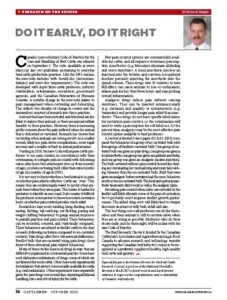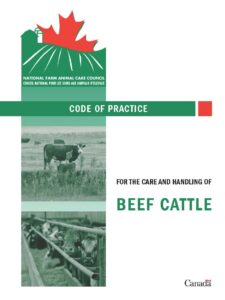Do it Early, Do it Right
This article written by Dr. Reynold Bergen, BCRC Science Director, originally appeared in the October 2013 issue of Canadian Cattlemen magazine and is reprinted with permission.
Remarque : cette page web n’est actuellement disponible qu’en anglais.
Canada’s new voluntary Code of Practice for the Care and Handling of Beef Cattle was released on September 6. The code (available at nfacc.ca) lays out guidelines pertaining to everyday beef cattle production practices. Like the 1991 version, the new code includes both should-do’s (recommendations) and must-do’s (requirements).The code was developed with input from cattle producers, industry stakeholders, veterinarians, researchers, government agencies, and the Canadian Federation of Humane Societies. A notable change in the new code relates to pain management when castrating and dehorning. This reflects two decades of change in society and the tremendous amount of research into these practices.
Animals that have been castrated and dehorned are less likely to injure other animals, so there are animal welfare benefits to these practices. However, there is increasing public concern about the pain inflicted when the animal that is dehorned or castrated. Research has shown that castrating when animals are young results in a smaller wound, likely less pain, fewer complications, more rapid recovery and a smaller setback in animal performance.
Starting in 2016, the new Code will require cattle producers to use pain control, in consultation with their veterinarian, to mitigate pain associated with dehorning calves after horn bud attachment (two or three months of age), or when castrating bulls older than nine months of age (six months of age in 2018).
It is not easy to know whether a beef animal is in pain, or whether pain relief is effective. Cattle are “stoic”. This means they are evolutionarily wired to not let other animals know when they are in pain. This makes it harder for predators to identify an easy meal. It also makes it difficult for producers or researchers to know how much castration hurts, or whether pain control provides much relief.
Researchers have used standing, lying, feeding, ruminating, kicking, tail swishing, ear flicking, pacing and weight shifting behaviors to gauge animal responses to painful practices and pain control. These behaviors can be recorded, counted, and statistically compared. These behaviors are altered in feedlot cattle in the days or weeks following castration compared to un-castrated controls. Pain drugs alter these behavioral differences. Feedlot bulls that are castrated using pain drugs show fewer of these abnormal, pain-related behaviors.
Many of these studies have used drugs in ways that are difficult to implement in commercial practice. Some have used elaborate combinations of drugs, some of which are not licensed for use in cattle. Others have used experimental formulations that are not commercially available for cattle (e.g. oral meloxicam). Others experiments have repeatedly given the pain drugs over several days, requiring additional handling, stress and risk of injury for the cattle.
Few pain control options are commercially available for cattle, and all require a veterinary prescription. Anesthetics (e.g.lidocaine) eliminate all feeling and cause numbness. A local anesthetic involves an injection into the testicles and scrotum. An epidural involves precisely injecting the anesthetic into the spinal column. These drugs take 10 minutes to take full effect, can cause animals to lose coordination, relieve pain for less than three hours, and may prolong wound inflammation.
Analgesic drugs reduce pain without causing numbness. They can be injected intramuscularly (e.g. metacam and anafen) or intravenously (e.g. banamine) and provide longer pain relief than anesthetics. These drugs do not have specific label claims for castration pain control, so the veterinarian will need to write a prescription for off-label use. At the present time, analgesics may be the most effective pain control option available to beef producers.
A Journal of Animal Science paper (81:1281-1293) compared the behavior of a group of un-castrated bulls with four groups of burdizzo castrated bulls. One group of castrated bulls was given no pain drugs, one group was given a local anesthetic, one group was given an epidural anesthetic, and one group was given an analgesic (anafen injection). The bulls castrated without pain control showed less feeding, less ruminating, less normal lying and more tail swishing behavior than the un-castrated bulls. Bulls that were given an analgesic before castration had the same behavior results as the un-castrated bulls. The local and epidural anesthetic treatments didn’t work as well as the analgesic alone.
Providing pain control when calves are castrated in the feedlot will likely alleviate some of the pain of castration, but it probably won’t improve feedlot growth performance. The added drug costs will likely lead to steeper discounts on intact or belly bulls at fall calf sales.
The best thing cow-calf producers can do for themselves and their animals is still to castrate calves when they are as young as possible. Producers who do their chores early, and do them right will be in line with the new Code of Practice.
Click here to subscribe to the BCRC Blog and receive email notifications when new content is posted.
The sharing or reprinting of BCRC Blog articles is welcome and encouraged, however this article requires permission of the original publisher.
We welcome your questions, comments and suggestions. Contact us directly at info@beefresearch.ca or generate public discussion by posting your thoughts below.

